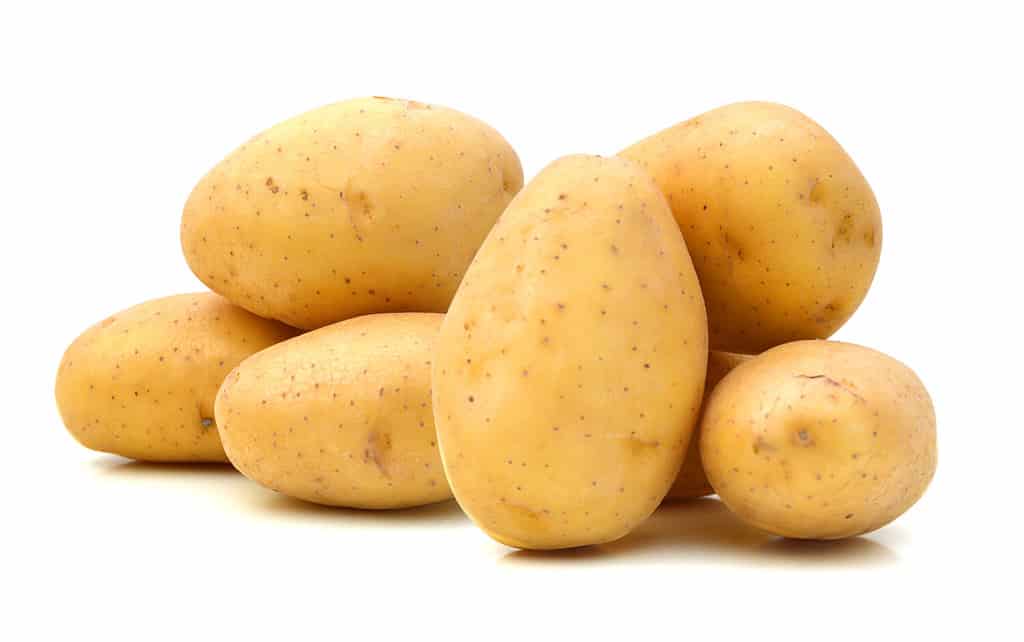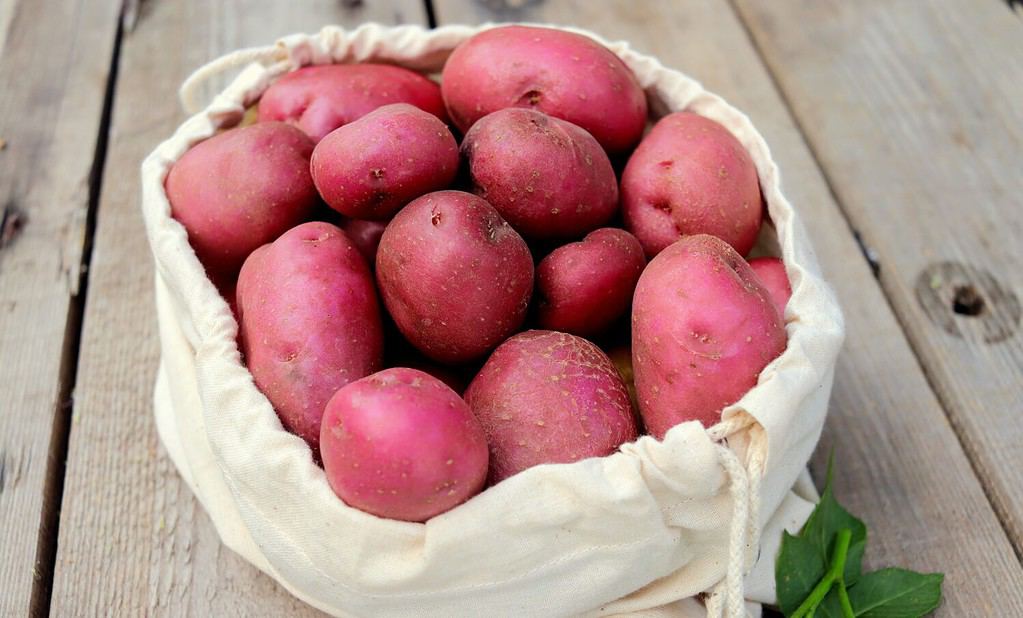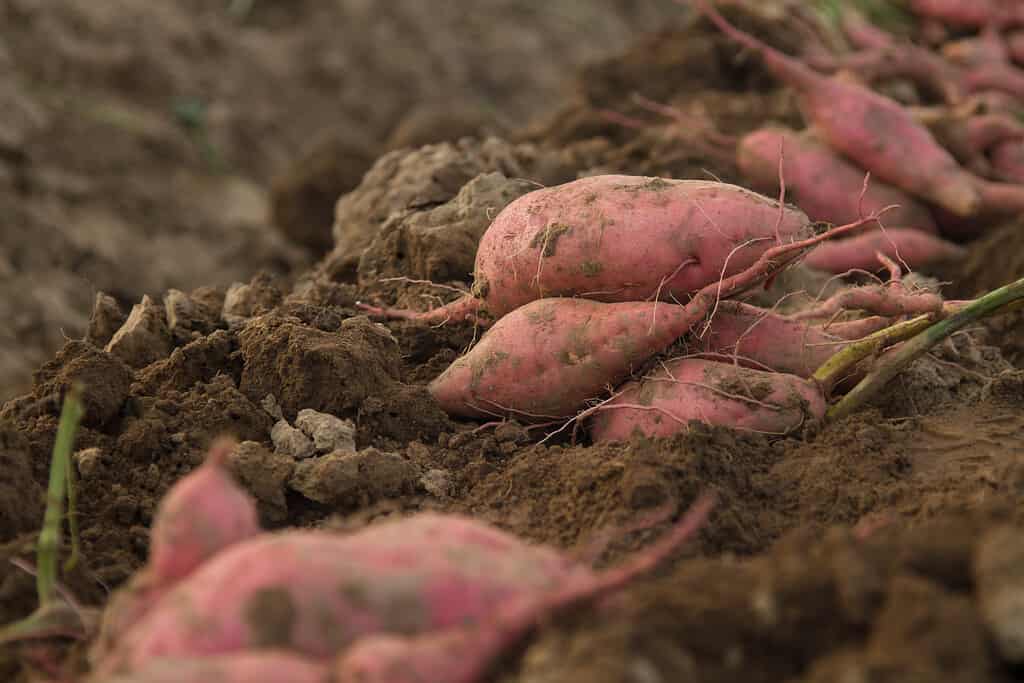If you’ve never grown crops hydroponically before, then potatoes are a great place to start. They are one of the easiest crops to grow hydroponically and are beginner-friendly.
Potatoes need light, water, and nutrients to grow, but they don’t need soil. That’s why hydroponic systems work so well for potatoes.
There are many reasons to grow potatoes hydroponically. You can grow potatoes year-round. You’ll have more control over your crops than if they grow underground. It’s also relatively easy once you get the hang of it.
Keep reading to learn how to grow potatoes hydroponically.
What are the Benefits of Growing Hydroponic Potatoes?

Potatoes are one of the easiest crops to grow hydroponically.
©Hong Vo/Shutterstock.com
The primary advantage of hydroponic growing is that you can grow potatoes year-round.
Many hydroponic potato growers keep their systems inside. It’s easier to care for the potatoes inside than outside. Keeping the systems inside means that conditions remain stable. Stable conditions lead to happier and healthier plants.
Indoor systems reduce the likelihood of annoying pests that can kill your crop. Your potatoes are also far less likely to develop destructive diseases or bacteria.
The Pros and Cons of Growing Potatoes Hydroponically
| Pros | Cons |
|---|---|
| *Produce potatoes year-round *There’s no need to use soil *Hydroponic systems are easy to set up and use *Requires less space than traditional growing *You can easily upgrade your hydroponic system as you want *Easy to grow indoors *Stable conditions lead to happy and healthy plants *Fewer pests *Less chance of bacteria or disease *You have more control over the nutrients your potatoes are getting *Hydroponic potatoes don’t go bad as quickly as those grown in soil | *Takes up lots of space indoors *The initial investment is high *Power outages can kill plants *It needs lots of water *More prone to waterborne diseases *You need some prior knowledge of hydroponics to be successful or be prepared to do lots of research *Problems can happen quickly, so you need to watch your system and potatoes closely *Soil-grown potatoes often taste slightly better than hydroponic-grown potatoes |
Read about the potato beetle, one of the worst potato pests that growers must deal with.
Here’s What You Need to Grow Hydroponic Potatoes
- Hydroponic System
- Deep Water Culture (DWC)
- Nutrient Film Technique (NFT)
- Grow lights
- Potatoes
- Growing medium
- Perlite
- Peat
- Vermiculite
- Nutrient solution
The best-growing medium for potatoes seems to be perlite or vermiculite. You can mix other mediums with them, but use primarily perlite or vermiculite. Peat is another suitable growing medium if you don’t like the other two.
A recent study shows that hydroponically growing potatoes in a wood fiber medium were highly successful for yield. Researchers produced 200% more potatoes than with traditional growing methods. Yet, the quality of the potatoes was reduced. So, this method needs more experimentation before we should use it.
Use a good-quality grow light to ensure your potatoes get 6-12 hours of sunlight daily. Try to give them at least 10 hours of light a day when possible.
We recommend starting with a pre-made nutrient solution. Then, you can add other nutrients to the solution as needed.
The Best Potatoes for Hydroponic Growing

Pick your favorite potatoes for hydroponic growing. One variety is not better than another.
©Olga Bondas/Shutterstock.com
There doesn’t seem to be one kind of potato that grows better than another. Pick your favorite potato and get growing.
One source says that the most popular potato varieties for hydroponic growing include Accent, Charlotte, Gold Rush, and Red Pontiac potatoes. You can even grow sweet potatoes hydroponically!
Avoid using potatoes from the grocery store. They usually spray them with anti-sprouting chemicals. Instead, grab some seed potatoes from your local farm or nursery.
Also, ensure you get healthy potato seeds. Avoid ones that don’t look good, as they won’t grow good potatoes.
Here’s How Long Potatoes take to Grow Hydroponically
Potatoes typically take between 70 to 90 days to grow hydroponically. The exact amount of time depends on the system you use.
Deep Water Culture (DWC) systems usually grow potatoes in about two to four weeks. Nutrient Film Technique (NFT) systems take a bit longer, at six to eight weeks.
The grow time is far faster than the typical four to five months when growing them in the ground!
Step-by-Step Instructions for Growing Hydroponic Potatoes
Follow these directions for growing potatoes hydroponically.
1. Choose Your Hydroponic System
Before you begin growing your potatoes, you’ll need to pick your hydroponic system.
There are two common hydroponic systems: DWC and NFT systems.
Deep Water Culture (DWC) systems are the easiest and are best for beginners. They allow anyone to grow potatoes hydroponically, even if you have limited space.
Nutrient Film Technique (NFT) systems are more complicated and take more work. Still, they are better for those wanting to grow lots of potatoes. These systems also make it easier to increase your production down the line.
2. Set Up Your Hydroponic System
Next, you’ll set up your chosen hydroponic system.
Regardless of your chosen system, your potatoes will need lots of nutrient-filled water. The key is ensuring the roots get plenty of water without submerging the potatoes.
DWC Hydroponic Systems
Deep Water Culture (DWC) systems require two containers. One container is for the potatoes to grow, and the other is for the nutrient solution. Most beginners use simple plastic containers. As you become more familiar with hydroponics, you may wish to use custom containers.
Keep the nutrient solution at a temperature between 68-72°F with a pH of about 6.0.
Most potatoes can survive in temperatures between 65-80°F, but 68-72°F seems to be the sweet spot.
A pH between 5.8 and 6.2 is also acceptable but aim for as close to 6.0 as possible.
NFT Hydroponic Systems
Nutrient Film Technique (NFT) systems use a channel. The channel allows the nutrient solution to flow through to feed the potatoes. The channels sit above the nutrient reservoir so the nutrients can flow through it.
Keep the nutrient solution at a temperature between 68-72°F with a pH of about 6.0.
3. Prepare and Plant Your Potatoes
After you’ve prepared your potatoes, you can finally plant them. Use large or small seed potatoes.
For large seed potatoes, cut them into pieces that have one or two eyes each.
You can plant small seed potatoes whole.
Put the potatoes away somewhere dark and dry for a few days. Once sprouts begin to appear, it’s time to plant.
DWC Hydroponic Systems
This system is the simplest. So, you can just plant the seed potatoes straight into their growing container. To do this, place a bit of the growing medium at the bottom of the container. Then, place the potatoes at the bottom of the container and place the growing medium on top.
NFT Hydroponic Systems
These systems are a bit more complicated. The potatoes will grow in grow baskets or tubes within the feeding channel.
4. Caring for Your Potatoes
Now that your systems are all set up, and your potatoes are planted, caring for the potatoes is the fairly easy part.
Regardless of your chosen system, you’ll need to keep an eye on the nutrient system. Test the pH regularly to ensure it stays around 6.0. Use a thermometer to check that the temperature stays between 68-72°F.
If you use a DWC system, you’ll need to fill up the nutrient reservoir as it gets low. Similarly, ensure there is always enough water running through the channels of the NFT system.
Regardless of the system, you must also ensure your potatoes get about 6-12 hours of light.
It’s easiest for you and safest for your potatoes if you use timers. The timers will ensure the lights turn on and off when they should. They also ensure the potatoes are getting water at the correct times.
Check on your hydroponic system regularly to ensure it is operating correctly. Take care of any issues immediately to ensure your potatoes grow healthy and strong.
5. Harvest Your Potatoes
Now that your potatoes are grown, you get to do the fun job of harvesting them.
Harvesting is similar for both systems. For a DWC system, you can simply dig the potatoes out of the pot. For an NFT system, you’ll have to take the potatoes out of the grow baskets or tubes.
To store the potatoes, keep them in a dry, dark place.
Maybe you’ve read through this guide and have decided that growing potatoes hydroponically is not for you. In that case, consider learning how to grow potatoes the traditional way.
Avoid These Problems

Most people don’t know that you can also grow sweet potatoes hydroponically!
©piyaset/ via Getty Images
Things can always go wrong when planting a new crop, but you can do your best to avoid issues.
Spot Nutrient Deficiencies
You’ll want to check your potatoes regularly to ensure they remain healthy while growing.
Potatoes that aren’t getting enough nutrients may get dry quickly. Their skin may begin cracking as they dry out. The potato’s color will likely change quickly, and the tubers and leaves will become too dark. The tubers may also have deformations, and they are likely to begin dying off.
Be sure to tweak your nutrient solution if any of these issues happen. You may also need to oxygenate the water.
Your Potatoes are too Small
One of the primary issues with hydroponics is that the potatoes often turn out too small. Too-small potatoes usually happen from using a poor growing medium. We recommend using Perlite or Vermiculite.
Potatoes may also be too small or develop disease if you don’t care for your system while growing your potatoes.
Check the system regularly to spot malfunctions early and fix them immediately. Always keep the systems clean and healthy. Prepare for power outages with a backup power source, like a generator.
Growing Hydroponic Potatoes Without Electricity
There are ways to hydroponically grow potatoes without electricity. This option is nice if you don’t want to worry about power outages.
These methods are also helpful in lowering the cost of producing potatoes. Growing mediums can be pretty pricey.
There are five ways to hydronically grow potatoes without electricity. These methods are described in the video below. These experimental methods were presented at a seminar at The International Potato Center in Lima, Peru, in 2008.
You can read about the last two growing methods in this scientific study.
To compare the methods, the growers used Red Salad, Yukon Gold, and All Blue potatoes. The “Wrap in Newspaper” and “Suspended Pot Hydroponic Method” seem the most effective.
1. Pot-in-Pot Method
In this method, you’ll place a 3-liter pot upside down inside a 9-liter pot. You’ll place growing medium on either side of the small pot and fill the top of the pot with dry grass or straw. The nutrient solution constantly soaks the bottom of the large pot.
2. Paper-Toweling
Place a paper towel over an upside-down tray sitting in a nutrient solution. The seed potatoes sit on top of the upside-down tray. The paper towel wicks the nutrient solution up to feed the potatoes.
3. Perforated Tray and Upside-Down Nursery Tray
You’ll place an upside-down nursery tray inside a tank. Place the potatoes in growing medium on either side of the tray and fill the rest with dry grass or straw. Place a tray with a perforated bottom over the top. The nutrient solution is just high enough above the upside-down nursery tray to keep the growing medium moist.
4. Wrap in Newspaper
Simply wrap the seed potato in moist newspaper and place it on an upside-down nursery tray. Moisten the newspaper with the nutrient solution. No growing medium is necessary.
5. Suspended Pot Hydroponic Method
You’ll slightly submerge a net pot in the nutrient solution. The growing medium will use capillary action to draw the nutrient solution upward and feed the roots. Ensure the potatoes themselves are not submerged in the nutrient solution.
The photo featured at the top of this post is © HannaTor/Shutterstock.com
Thank you for reading! Have some feedback for us? Contact the AZ Animals editorial team.







